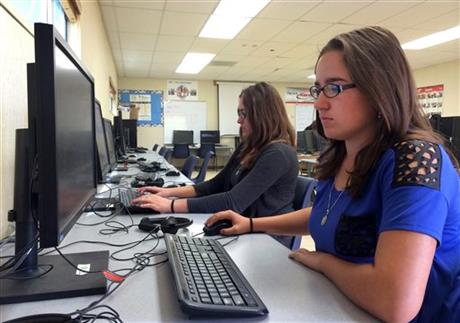
By CHRISTINE ARMARIO and SALLY HO
Nestled between mountains 60 miles from the nearest city, students at Cuyama Valley High School use Internet connections about one-tenth the minimum speed recommended for the modern U.S. classroom.
So when it came time to administer the new Common Core-aligned tests online, the district of 240 students in a valley of California oil fields and sugar beet farms faced a challenge.
New Cuyama has no access to fiber optic cables. Some residents live entirely off the grid, relying on solar power and generators. The local telephone company provided a few extra lines, but that only bumped speeds a few megabits.
“We tripled our capacity but it’s still woefully inadequate,” said Paul Chounet, superintendent of the Cuyama Joint Unified School District.
Across the country, school districts in rural areas like New Cuyama and other pockets with low bandwidth are confronting a difficult task: Administering the new standardized tests to students online, laying bare a tech divide in the nation’s classrooms.
Overall, 63 percent of public schools don’t have access to broadband speeds needed for digital learning. The problem is particularly acute in rural and low-income districts: Only 14 percent in those areas meet high-speed internet targets.
“It’s just very uneven all over the country,” Lan Neugent, executive director of the non-profit State Educational Technology Directors Association.
The Federal Communications Commission approved a $1.5 billion spending cap increase for school broadband and Wi-Fi last year that is expected to significantly boost connectivity. State grants linked to Common Core implementation and collaborations with tech and business leaders are also bridging the gap. But those initiatives could take a year or more to connect thousands of schools and testing started in 29 states and the District of Columbia for 12 million students this year.
In the meantime, they’re resorting to alternatives: Testing students in small groups, busing them to other schools and limiting all other internet access while exams are taken.
On a recent testing day in New Cuyama, 11 students filed into the high school’s small computer lab. Even with such a small number of test takers, students said they’d gotten kicked offline and had to log in again.
“It got me off track,” said Brian Olivas, 17.
The Common Core standards adopted in 43 states and the District of Columbia provide uniform benchmarks for what students should know in each grade in reading and math. To aid their adoption, two groups of states received grants from the U.S. Department of Education to develop new assessments required to be computer based.
By administering the tests online, educators can test more skills. Students can be asked, for example, to demonstrate how they would conduct a science experience or solve a math problem, rather than just bubble in an answer.
Some states were already administering their tests by computer. The vast majority, however, had to quickly bring their technology and infrastructure up to speed.
A survey by the Center for Education Policy found most districts had concerns about hardware and internet speeds and more than half said they didn’t expect to have the technology infrastructure in place to administer the test until this year or later.
The tech challenges come as the Common Core standards and testing face continued resistance. Thousands of parents in New York and a handful of other states chose to opt their children out of the new exams this year. And the standards have already become fodder for the 2016 presidential elections, with early Republican contenders like senators Marco Rubio and Ted Cruz dismissing them as a federal intrusion forced on students, even though they were adopted by states.
Ideally, technology can help eliminate achievement gaps between poor and rural students and their more affluent peers. The shift to online testing, however, reveals how wide the digital divide remains. Districts like Chicago Public Schools with large numbers of low-income students have raised questions about whether their students — who often don’t have access to a computer or the Internet at home — are at a disadvantage.
“The implementation of Common Core is bringing these issues more to the forefront,” said Brian Smith, executive director of the nonprofit Education Trust-West. “But this has been an issue that has plagued communities of color and low income communities for years.”
Nevada, Montana and North Dakota all dealt with crippling outages at the hands of their test maker, Measured Progress and Smarter Balanced consortium, believed to be linked to a server capacity issue traced down to initial coding problems. Florida, Colorado, New Jersey and other states also experienced glitches.
In light of those issues, some districts have resorted to the paper test.
In New Cuyama, Chounet expects to get internet speeds up to the recommended 100 megabits per second by next year with the help of a state grant that will connect schools to higher bandwidth.
Chounet said those updates can’t come quick enough.
“Even though we’re isolated we have to provide students the technology skills,” he said. “When they leave here, that’s going to be the expectation.”
_
Associated Press writer Sally Ho reported from Las Vegas.



